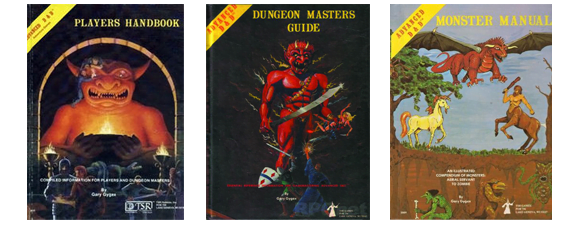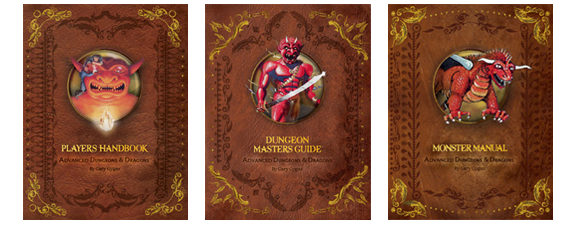Three Books From the Past
Published By: Derek on July 17th, 2012
Today, three “new” books release at Battleground. They are the reprints of the original Advanced Dungeons & Dragons hardcover rulebooks that were published in 1977-1979. Now commonly referred to as 1st Edition Dungeons & Dragons, these books were the moment in history when D&D really began to secure its foothold. The game’s origins actually lie a bit further back in the early 70s, but it was the release of these three tomes that marked the first serious step toward reaching a much wider audience.
It’s amusing for me to think back now and remember that when they were first introduced to me by a friend, I had no interest in playing the game. I was ten years old and pretty much the only thing I was interested in was Star Wars. In my basement, we had an old, rickety pool table that we used to build miniature cities on, out of a mish-mash of Star Wars sets (as well as other popular action-figure toys from that era, like Micronauts and G.I. Joe). This friend of mine, Jake, had moved away a year prior, and on this particular visit, had come down to stay for the weekend. It took him at least a full day to convince me that we should play this new game he had brought with him called Dungeons & Dragons. Eventually, and with great reluctance, I sat down at my dining room table with him to “roll up a character.”
I distinctly remember “not getting it.” All these classes and races and spells and numbers and numbers and numbers… It was definitely a chore for him to keep me patient and interested. I just couldn’t see the point or where it was going. But something happened when we started to play. There was a moment when everything clicked for me, and I finally understood what was happening. “I can do anything?” I asked. The reply was repeatedly, “Yes,” and that answer just baffled me.
Anything.
It always makes me laugh to think about how hard Jake had to campaign to get me to try this game. How could I have known that it would capture my imagination so completely, and the roads down which it would eventually lead me. It seems quite fair to say that Battleground Games & Hobbies might not exist if it weren’t for that weekend in the summer of 1982 when my first D&D character, Sir Robert, would brave the labyrinthine corridors of the Lost City.
By the end of the weekend, it was Jake that was ready to do something else, but I would hear nothing of it. We played right up until the moment his mother came to pick him up to take him home. From that weekend forward, Dungeons & Dragons became a passion on par with Star Wars. It didn’t unseat my first love, but it was right there beside it. Over the years that followed, I consumed everything I could get for D&D. My 1982 Christmas list was itemized, in order of preference, which D&D books I wanted. At the top of the list was the AD&D Dungeon Master’s Guide, for while I enjoyed playing the game as Sir Robert, it was what was happening behind the screen that truly fascinated me. How was it that Jake was prepared to determine any action I would take? Were there really rules for everything? I had to know.
We all remember those Christmases that really delivered. 1982 was one of those years for me. I hardly cared about the rest of my presents after I tore the wrapping paper off of the Dungeon Master’s Guide. I remember wanting to do nothing other than sit down and start to read its contents the second I had opened it. Over the coming months (and subsequent years) I can tell you, with no embarrassment, that unlocking the secrets contained in that volume was one of the richest memories from my childhood. For any of you that experienced similar connections to the game, you will know exactly what I’m talking about.
The game’s author and creator was Gary Gygax, and there was something mystifying about the way he wrote. Most rules have a tendency to be very sterile. Not so, Gygax’s style. Consider this excerpt from the DMG, wherein he defines Wisdom:
For game purposes wisdom ability subsumes the categories of willpower, judgment, wile, enlightenment, and intuitiveness. An example of the use of wisdom can be given by noting that while the intelligent character will know that smoking is harmful to him, he may well lack the wisdom to stop (this writer may well fall into this category).
He’s talking to you; he’s sharing a bit of himself. It’s personal, and it’s engaging. Not everyone prefers this now, and I’m not suggesting it’s the better way to write rules. All I can say for sure is that it spoke to me in a way at age eleven that would not have been the same had it been, say, the 4th edition Dungeon Master’s Guide I happened to be reading.
For those of you that have never approached these books before, I strongly suggest you pick them up. It may very well be that you never try to actually play 1st Edition Dungeons & Dragons; the gaming universe does seem to have changed in fundamental ways since they were written. Many of the rules are archaic, bizarre, and non-intuitive. People familiar only with modern D&D will be mystified at the notion of numerically declining Armor Class numbers (“What do you mean -3 AC is better than 6 AC?”). It might be very easy for a reader to miss the buried explanation as to why a magic missile only has a range of 6″ + 1″/level. I’m not sure any living human has ever correctly interpreted the rules for pummeling, grappling, and overbearing.
But there is something extraordinary within the covers of these tomes. Concealed within the ocean of 9-point font of block text are the roots to a giant tree that never stopped growing. Some of those branches have withered and died over the years, but the fruit from the tallest limbs can still be had. It’s my hope that D&D 5th edition will be one such fruit. The re-release of these books hints that the designers of the upcoming edition are hoping the same.
Finally, these books help honor the memory and work of Gary Gygax. Each purchase of these monumental books helps support the Gygax Memorial Fund, established to immortalize the “Father of Roleplaying Games” with a memorial statue in Lake Geneva, Wisconsin.





Social: